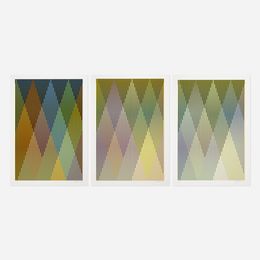
Presentation
Carlos Cruz-Diez (Caracas, Venezuela, 1923 - Paris, France, 2019) is one of the major figures of kinetic and optical art and has received numerous awards for his work. His practice positions him as a contemporary theorist of color. His visual research, based on three chromatic conditions -- subtractive color, additive color, and reflection -- has contributed to a new approach of the color phenomenon by expanding his perceptual universe.
Carlos Cruz-Diez based his practice on the color as an autonomous reality, without any anecdote, evolving in real-time and real space without any help from the form or the support. There are eight axes of research that reveal the different behaviors of color: Additive Color, Physichromie, Chromatic Induction, Chromointerference, Transchromia, Chromosaturation, Chromoscope, and Color in Space.
In 1940, Carlos Cruz Diez was studying at the Art School in Caracas. In 1944, he was working as a graphic designer for the "Creole Petroleum Corporation". In 1946, he became the Creative Director of the advertising agency "McCann-Erickson in Venezuela. In 1957, he founded the "Estudio Artes Visuales" dedicated to graphic and industrial design. In 1959, he completed his first work entitled “Additive Color and Physiochromia".
In 2005, his family created the "Cruz-Diez Foundation" dedicated to the conservation, development, dissemination, and research of the artist's conceptual heritage. Between 1972 and 1973, he taught "Kinetic Techniques" at the Beaux-Arts School in Paris. In 2012, he was appointed Officiel the National Order of the Legion of Honour.
Filter by :

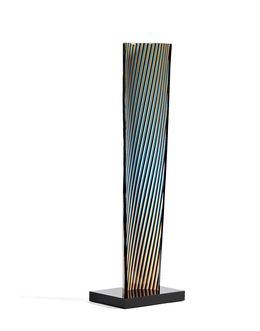
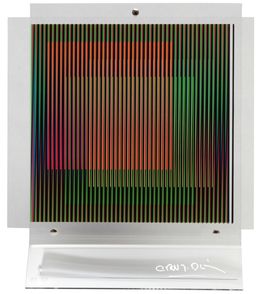
Chromointerference manipulable la difference
Carlos Cruz-Diez
Sculpture - 40 x 35 x 10 cm Sculpture - 15.7 x 13.8 x 3.9 inch
$11,821

Couleur a l’espace ariel
Carlos Cruz-Diez
Sculpture - 52 x 12 x 12 cm Sculpture - 20.5 x 4.7 x 4.7 inch
$13,597
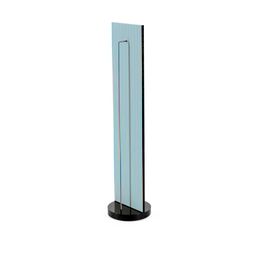
Couleur à l’espace nova
Carlos Cruz-Diez
Sculpture - 52 x 12 x 12 cm Sculpture - 20.5 x 4.7 x 4.7 inch
$13,597

Cromovela triptych 13
Carlos Cruz-Diez
Sculpture - 60 x 50 x 13 cm Sculpture - 23.6 x 19.7 x 5.1 inch
$21,034

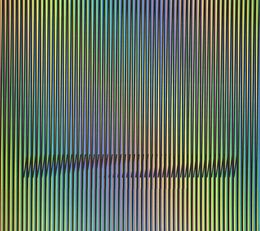








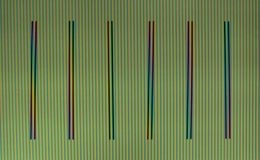
Couleur à l'Espace Olot
Carlos Cruz-Diez
Print - 70 x 100 x 0.1 cm Print - 27.6 x 39.4 x 0 inch
$16,872 $12,654

Couleur à l'Espace Jerez
Carlos Cruz-Diez
Print - 70 x 100 x 0.1 cm Print - 27.6 x 39.4 x 0 inch
$16,872 $12,654

Induction du Jaune Masnou
Carlos Cruz-Diez
Print - 50 x 80 x 0.1 cm Print - 19.7 x 31.5 x 0 inch
$14,763 $11,072

Induction du Juane Rioja
Carlos Cruz-Diez
Print - 50 x 80 cm Print - 19.7 x 31.5 inch
$14,763 $11,072

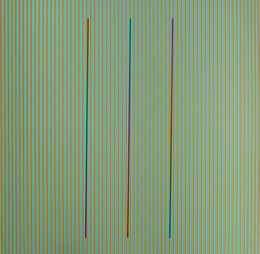

Induction du Jaune Tepuy 2
Carlos Cruz-Diez
Print - 60 x 60 x 0.1 cm Print - 23.6 x 23.6 x 0 inch
$8,880

Induction du Jaune Tepuy 1
Carlos Cruz-Diez
Print - 60 x 60 x 0.1 cm Print - 23.6 x 23.6 x 0 inch
$8,880 $6,216







Induction du Jaune Tepuy 3
Carlos Cruz-Diez
Print - 60 x 60 x 0.1 cm Print - 23.6 x 23.6 x 0 inch
Sold
Exhibitions dedicated to Carlos Cruz-Diez

Ground Effect
Les Docks x Ground Effect
From August 21, 2021 to August 29, 2021

Ground Effect
Good Bye 2020
From December 10, 2020 to January 10, 2021

Ground Effect
Out Of Ground Effect
From September 17, 2020 to September 30, 2020

Ground Effect
Ground Effect Summer Group Show
From August 3, 2020 to August 30, 2020
Discover our selections of works by artists
What are their 3 main works?
What is Carlos Cruz-Diez’s artistic movement?
When was Carlos Cruz-Diez born?
